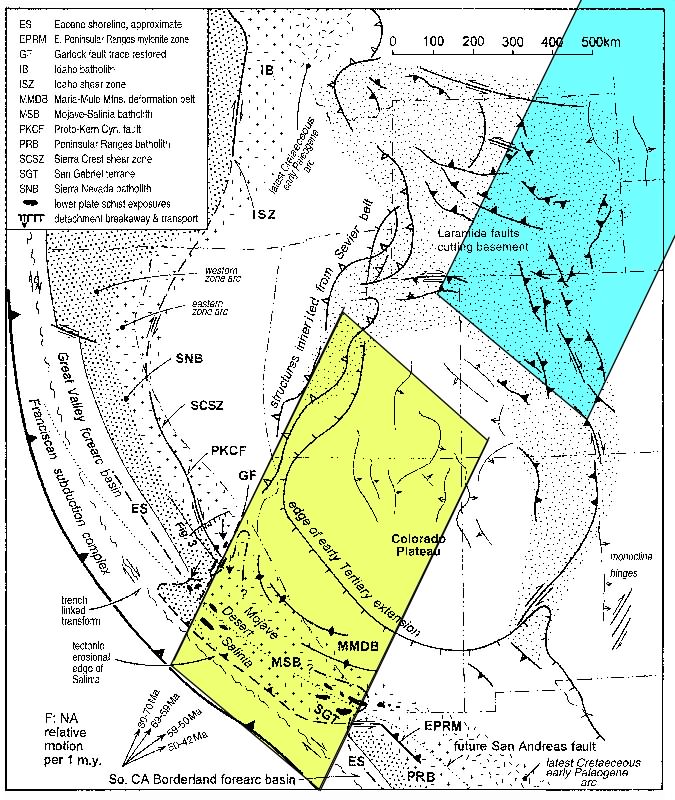
Colorado Mineral Belt
The Debate
Where did they come from, and why are they here?
For years scientists have tried to relate Laramide tectonism and magmatism in the CMB, but with little conclusive success. Early attempts suggested that partial melting of the downgoing slab created magma. Flat plate or "variable dip" subduction models followed, and later hot mantle upwelling were postulated as potential causes for the magmatism within the CMB
Early hypothesis of magma genesis due to partial melting of a subducted slab went further to imply that the chemical signatures of the resulting igneous rocks could be used to predict the position of the subducted slab (Dickinson and Hatherton, 1967; Hatherton and Dickinson, 1969). Inherent in this hypothesis is the idea that all melts produced at the same slab depth would bear the same chemical signatures; and that the K20:SiO2 ratios are a function of the position of the slab (Mutschler et al, 1987). Dickinson and Hatherton (1967, and Hatherton and Dickinson, 1969) looked at subduction related island arc andesites with 55 and 60 weight percent SiO2 and plotted the andesite K2O content against known depths to the related Benioff zones. The authors cited increases in K2O content with depth to the seismic zones across the subduction zone, claiming that this relationship (K-h) could be used to determine depth to the subducting plate. Andesitic magma generation was said to occur with depths to the Benioff zone of 80-290km (Hatherton and Dickinson, 1969).

(Hatherton and Dickinson, 1969)
Later work concluded that these postulates were flawed, as some arcs showed reverse relationships between known depth and K, different arcs had different K-h relationships (Middlemost, 1985), K content was recognized to change temporally and spatially across some arcs (Barker, 1983), and other processes such as crustal interactions, crustal thickness, and hydrothermal alteration may change the K20 values regardless of depth of melt (Mutschler et al, 1987). In a study of minerals in the Cripple Creek district by Gott et al (1969), the scientists recognized replacement of sodium by potassium in some rocks and minerals, indicating that post-eruptive processes can also alter the K2O ratios of igneous rocks.
Similar flat and variable dip subduction models have also been called upon to explain CMB magmatism. The idea is that asthenospheric upwelling at the front edge of the subducting slab produces melts. Any gaps in magmatism, such as those seen in the Great Basin and Colorado Plateau during the Laramide, are the result of the slab encroaching on the continental lithosphere and preventing upwelling asthenosphere from entering these areas. Later, removal of the flat slab would facilitate the ignimbrite flareup (Eric Cannon) following Laramide magmatism. While this remains a popular hypothesis, there are a few problems with CMB magma genesis from flat slab subduction, as well. To name a few, there is no geophysical evidence that there is any slab under the area today (Humphreys, 1995; Mutschler et al, 1987), slab-derived chemistries are not found in the igneous rocks, and unconstrained ages of magmatic events do not necessarily match up with suggested plate positions at given times.
The figure below shows a pre-Neogene palinspastic western North America base map with the proposed migration of the “flat slab” relative to North America at ~70 Ma (yellow), and 60Ma (blue) assuming 10 My of subduction of a flat slab. Using this reconstruction negates the possibility of Laramide age CMB igneous rocks as the result of melting at the leading edge of the flat slab. Volcanic activity is known to have initiated in the east and northeast portions of the figure prior to when the flat slab would have swept through.

(From Saleeby, 2003)
Later models suggest generation of magma without requiring a subducted plate (Mutschler et al, 1987; Mutschler et al, 1998; Stein and Crock, 1990). These models instead call upon passive ‘hot spots’ (Mutschler et al, 1998) or mantle metasomatism and lithospheric deformation to drive mantle upwelling, resulting in lower crustal (Stein and Crock, 1990) and mantle melting (Mutschler et al, 1987). Crustal roots produced during Laramide compression created initial depression of isotherms. Erosion of uplifts at the continental surface allowed uplift of the roots, and consequently, of the isotherms below, warming the roots. Continued erosion and uplifting generated higher heat flux just below the roots until roots were lifted enough to allow decompression melting. Some melts found their way to the earth surface through crustal weaknesses and resulted in alkaline basalts, while some ponded in (or under) the crust. Ponded magmas interacted with the crust and later made their way to the surface as calc-alkaline magmas (Mutschler et al, 1987).


Mutschler et al, 1988
Back to ages | Home | References | on to what do the rocks have to say?